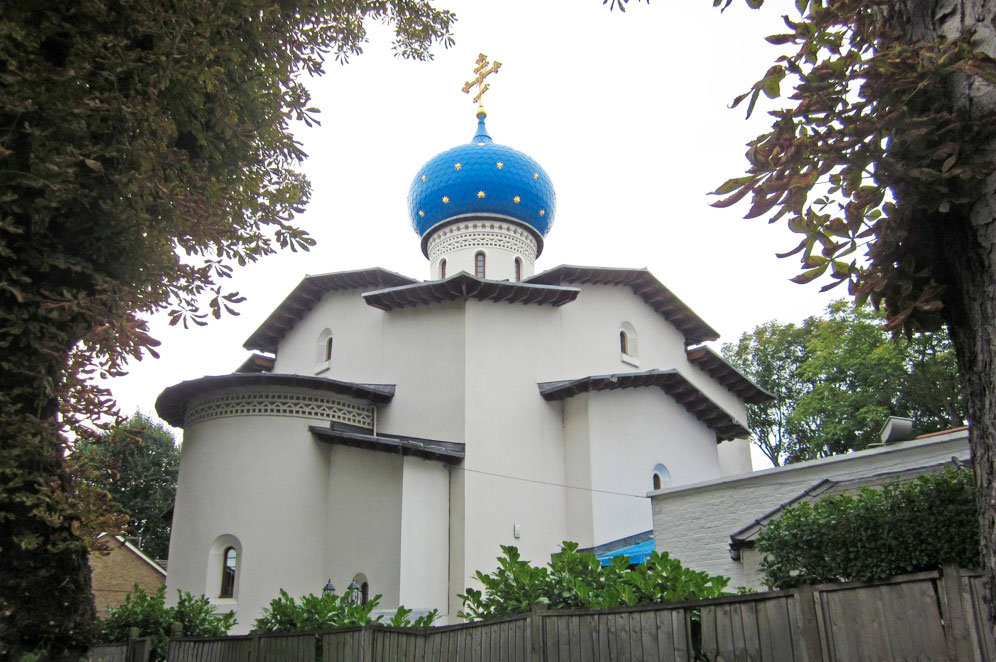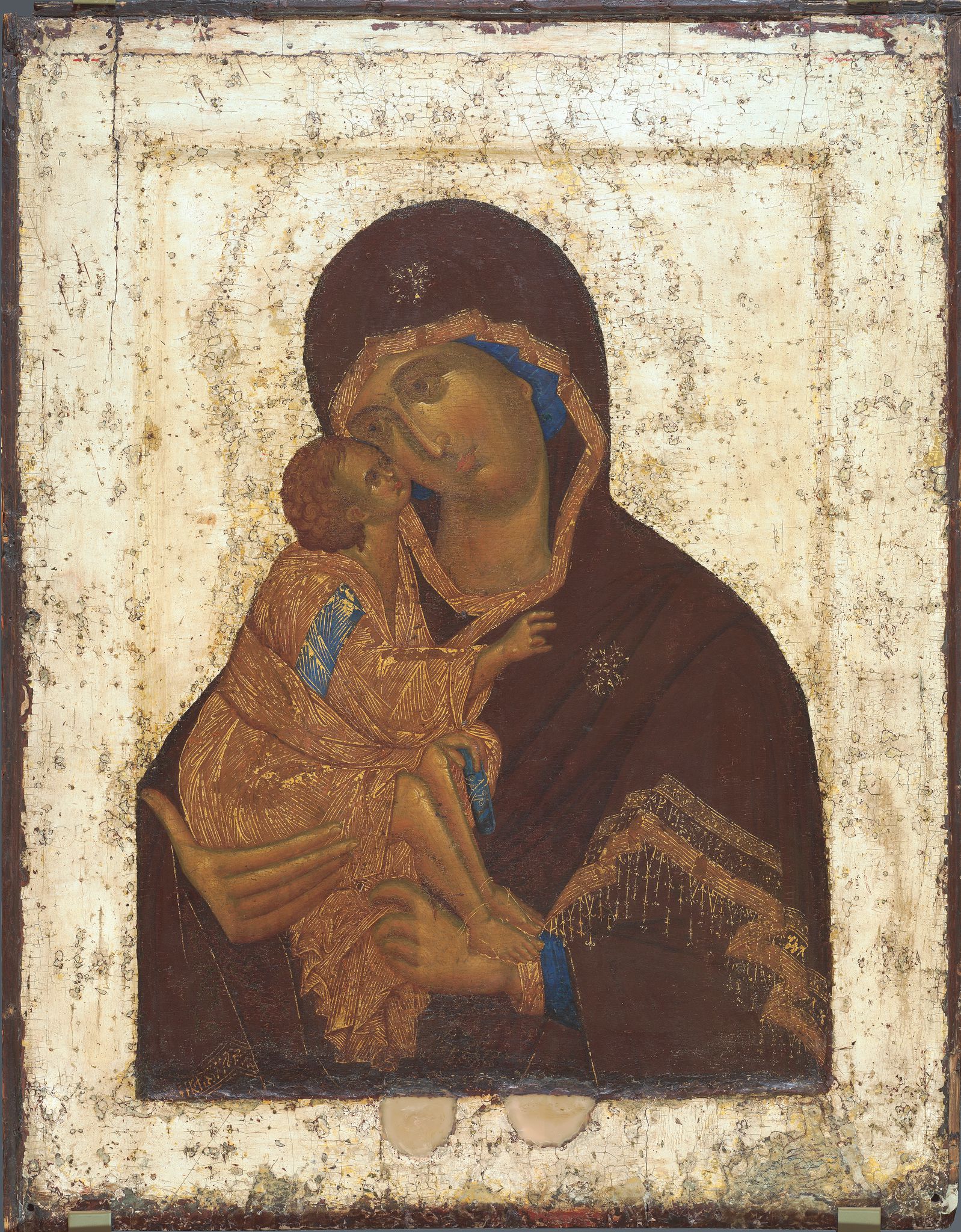Orthodox Russian London

Russian Dormition Church in Chiswick
Phoebe Taplin
Source: Phoebe Taplin and Rex Features
On a leafy lane near Chiswick, in south-west London, the blue dome of a Russian Orthodox church rises surreally above the chestnut trees. Visible to drivers along the M4 on their way to and from Heathrow Airport, the Cathedral of the Dormition of the Mother of God and the Holy Royal Martyrs is, as the unwieldy name suggests, a symbolic statement of traditional faith in a city that growing numbers of Russians are adopting as a home from home.
With its classic onion dome, fretted with golden stars, tiny arched windows in the high whitewashed walls, as well as its signs in Russian, candles, icons and head-scarfed women, the Chiswick church certainly has the potency of a symbol. Its slightly remote location means it sometimes lacks the requisite energy.
A sign on the gate thanks the anonymous passers-by whose swift action in calling the police prevented recent thieves from further looting and vandalising the building.
The busy Cathedral of the Dormition and All Saints, located more centrally on Ennismore Gardens in Knightsbridge, holds morning and evening services every day. The church is part of the “Diocese of Sourozh” under the Moscow Patriarchate. Its guiding light for many years was the charismatic Metropolitan Anthony, who died in 2003. He developed a flexible, cosmopolitan brand of Orthodoxy, where rules about headscarves and fasting were less strictly enforced. Many post-Soviet Russians arriving in London were unhappy about the laxity they found here, one of the causes of recent tensions and divisions.
According to one ex-parishioner, who prefers to remain anonymous as the issues involved are so sensitive, there have been several distressing splits between different groups within the Russian Orthodox Church in London. She says Metropolitan Anthony chose in the 50s and 60s to keep links with the Soviet Orthodox Patriarchate “in order to be allowed to visit Russia and send recordings and messages, which were a lifeline for all the secret Orthodox believers in the USSR.” There have been divisions between newer Russian expats and “descendants of Russian revolution refugees and later British converts”. She concludes sadly: “There seem to be so many warring factions now that I have now given up going anywhere.”
For those who have weathered the religious storms, the church is clearly an important centre for the Russian community; the notice boards are heaving with adverts: pilgrimages to Kiev and calls for film extras for Anna Karenina; nannies wanted and lost dogs sought. All life is here. You can even order organically-grown dill for that authentic Russian taste.
With its soaring Italianate bell tower and rose window, the church is a beautiful setting for the aesthetically rich Orthodox traditions. The iconostasis, a screen of gold-backed icons separating the priest’s sanctum from the rest of the church, glows in the light of numerous bees wax candles, exuding that pungent and distinctive smell of honey.Icons have always been a crucial part of Orthodox worship. As Richard Temple, who founded the Temple Gallery in 1959, explains: “Icons are part of the liturgy. The saints are present through their icons”. As a long-term collector, dealer and devotee, Temple believes that “icons have their own message in a material world”, a spiritual impulse you can powerfully sense in the tiny gold-on-gold gallery below his magical shop in Holland Park.
“My fascination is how Christianity emerges out of Hellenistic culture,” says Temple, who has written several books about icons including one titled Icons and the mystical origins of Christianity, now sadly out of print, but available second-hand. “It’s not fashionable,” adds Temple, explaining that art historians find the spiritual dimension of icons “embarrassing”. For Temple, it is precisely the “combination of artistic mastery and spiritual insight” that is so compelling, producing images “through which the artist’s gaze on eternity is reflected back to us.”
Temple has been involved in campaigns to open a dedicated icon room in the British Museum, which holds around a hundred icons of which ten are considered world class. A catalogue has been published and a Russian oligarch even offered to fund the display, but there is – as yet – little academic willingness to embrace this awkwardly mystical branch of art. Interest in icons is growing in other areas, though. Commercially, they are becoming more popular and artistically there has been a revival of older techniques. Irina Bradley of the Prince’s School of Traditional Arts in Shoreditch runs icon painting workshops.
Orthodox services are also held in St Andrew’s Church in Holborn (together with its sister parish in Clapham on alternate weekends), as part of the ecumenical Parish of the Dormition. St Andrews is not so permanently permeated by the nostalgic whiff of Russia as All Saints. The gold-robed priest and bleeding Christ behind him look a little startling in the barrel-vaulted church, rebuilt in the 1680s by the architect of St Paul’s Cathedral, Sir Christopher Wren.
London’s Russian Orthodox Church outside Russia (ROCOR) and its precursors have had a peripatetic history. There have been orthodox chapels in London since Peter the Great’s visit here in the late 17th century, but the activities of the church in exile intensified massively after the revolution. The beautiful hidden chapel on Welbeck Street, now used by commercial offices, hosted a memorial ceremony for the murdered Romanovs in 1917.
Since then London parishioners have worshipped in a variety of venues, including a church where Victoria coach station is now, a tiny chapel in Hammersmith and a church hall in Emperor’s gate. ROCOR has been involved in the canonisation of 30,000 new martyrs to and confessors of the Orthodox faith, killed and persecuted during the atheistic Soviet era.
A 1927 schism was patched up by the energetic Archimandrite Nicholas who, when he became a bishop, was instructed to “be not only an Orthodox servant of God, but a servant of Russia, sharing the highest sympathies with our Russian people.” Seeing no conflict between patriotism and universal love, Nicolas also had a special remit to foster Anglican converts to Orthodoxy.
It was Metropolitan Anthony, though, who remains the landmark figure in London’s Russian Orthodoxy. He was an intriguing character, working as a surgeon in the French army and secretly becoming a monk. His father was an imperial Russian diplomat; his mother was composer Alexander Scriabin’s sister. An international conference in Moscow in September on "The Church as community both human and divine" is dedicated to his legacy.
Geraldine Fagan, an expert on religious policy in Russia and soon to publish a book on the subject, describes Anthony as “greatly responsible for the Russian Orthodox Church having any presence in Britain at all” and says that “many people who became Orthodox in the UK did so precisely because of him”. On the noticeboard of the Ennismore Gardens cathedral, there are directions to his grave.
Overgrown with creepers and wild flowers, Brompton Cemetery is one of London’s most atmospheric corners, part neoclassical mausoleum, part rural churchyard. Metropolitan Anthony is buried near the colonnaded necropolis under a black orthodox cross, surrounded by bunches of roses and pots of lilies from some of the many believers whose lives he touched.
All rights reserved by Rossiyskaya Gazeta.
Subscribe
to our newsletter!
Get the week's best stories straight to your inbox

